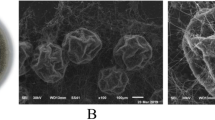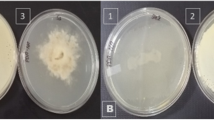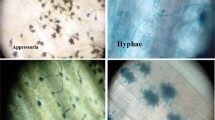Abstract
Bipolaris sorokiniana synthesizes the 1,8-dihydroxynaphthalene (DHN) melanin via pentaketide pathway and promotes the development of aerial mycelia and conidia. A melanin biosynthesis inhibitor Tricyclazole (TCZ), brought changes when applied at 5–100 μg ml−1 concentration in the colony morphology, radial growth, mycelia weight, melanin content, antioxidant enzymes (SOD and CAT) and extracellular hydrolytic enzymes (cellulase, pectinase, amylase and protease) in black, mixed and white isolates of B. sorokiniana. A significant alteration was recorded in antioxidant enzymes in black and mixed isolates; however, non-significant alteration was recorded in white isolate. Isolates of B. sorokiniana exposed to 100 µg ml−1 TCZ showed significantly increased formation of superoxide radical (O ·−2 ) and hydrogen peroxide (H2O2)·H2O2 was detected significantly high in hyphae and conidia while, O ·−2 was found primarily in the conidia. Microscopic results suggest that TCZ damages not only the cell wall but also the cell membrane. The foliar application of TCZ (25, 50 and 100 µg ml−1) decreases the area under disease progress curve, lesion development and spore formation on barley leaves thereby reducing potential for the disease development. In conclusion TCZ influences the pathogenic ability by damaging the cell structure of hyphae and conidia and also alters the antioxidant enzyme levels in B. sorokiniana. TCZ may therefore, works against to pathogen for better management of spot blotch disease in barley infected with B. sorokiniana.




Similar content being viewed by others
References
Apel K, Hirt H (2004) Reactive oxygen species: metabolism, oxidative stress and signal transduction. Annu Rev Plant Biol 55:373–399
Aver’yanov AA, Pasechnik TD, Lapikova VP, Gaivoronskaya LM (2001) Fungitoxic responses of rice callus culture as an expression of inheritable resistance to blast. Implication of active oxygen. Plant Physiol Biocehm 39:415–424
Barnett EA, Fergus CL (1971) The relation of extracellular amylase, mycelium and time in some thermophilic and mesophilic Humicola species. Mycopathol Mycol Appl 44:131–141
Bashyal BM, Aggarwal R (2013) Molecular identification of Fusarium species associated with bakanae disease of rice (Oryza sativa) in India. Indian J Agric Sci 83:71–76
Bashyal BM, Chand R, Kushwaha C, Sen D, Prasad LC, Joshi AK (2010) Association of melanin content with coniodiogenesis in Bipolaris sorokiniana of barley (Hordeum vulgare L.). World J Microbiol Biotechnol 26:309–316
Beauchamp CO, Fridovich I (1971) Superoxide dismutase: improved assay and an assay applicable to acrylamide gels. Anal Biochem 44:176–287
Beers RF, Sizer IW (1952) Colorimetric method for estimation of catalase. J Biol Chem 195:133–139
Bell AA, Wheeler MH (1986) Biosynthesis and functions of fungal melanins. Annu Rev Phytopathol 24:411–451
Bloomfield BJ, Alexander M (1967) Melanins and resistance to fungi to lysis. J Bacteriol 93:1276–1280
Bradford MM (1976) A rapid and sensitive method for the quantification of microgram quantities of protein utilizing the principle of protein-dye binding. Anal Biochem 72:248–254
Brendan J, Foran, Kastenmeier B, Bright DS (2003) Determination of pore-size distributions in low-k dielectric films by transmission electron microscopy. CP683, characterization and metrology for VLSI technology: international conference
Butler MJ, Day AW (1998) Fungal melanins: a review. Can J Microbiol 44:1115–1136
Chand R, Singh HV, Joshi AK, Duveiller E (2002) Physiological and morphological aspects of Bipolaris sorokiniana on wheat straw. Plant Pathol J 18:328–332
Chand R, Pandey SP, Singh HV, Kumar S, Joshi AK (2003) Variability and its probable cause in natural populations of spot blotch pathogen (Bipolaris sorokiniana) of wheat (T. aestivum L.) in India. J Plant Disease Prod 110:27–35
Chand R, Yadav OP, Bashyal BM, Prasad LC, Joshi AK (2013) Technique for the maintenance of heterokaryotic isolates of Bipolaris sorokiniana. Indian Phytopathol 66:61–65
Chand R, Kumar M, Kushwaha C, Shah K, Joshi AK (2014) Role of melanin in release of extracellular enzymes and selection of aggressive isolates of Bipolaris sorokiniana in Barley. Curr Microbiol 69:202–211
Chattopadhyaya A, Kushwaha C, Chand R, Srivastava JS (2013) Differential mode of action of tricyclazole in vitro and in planta on Bipolaris sorokiniana causing spot blotch in barley. Indian Phytopathol 66:155–158
Chaube HS, Pundhir VS (2005) Crop disease and their management (Google e-book). PHI Learning Pvt. Ltd, Mumbai
Chaurasia S, Joshi AK, Dhari R, Chand R (1999) Resistance to foliar blight of wheat: a search. Genet Res Crop Evol 46:469–475
Cheng Q, Kinney KA, Whitman CP, Szaniszlo PJ (2004) Characterization of two polyketide synthase genes in Exophiala lecanii-corni, a melanized fungus with bioremediation potential. Bioorg Chem 32:92–108
Chida T, Sisler HD (1987) Effect of inhibitors of melanin biosynthesis on appressorial penetration and reductive reactions in Pyricularia oryzae and Pyricularia grisea. Pestic Biochem Physiol 29:244–251
Chowdhury AK, Singh G, Tyagi BS, Ojha A, Dhar T, Bhattacharya PM (2013) Spot blotch disease of wheat- a new thrust area for sustaining productivity. J Wheat Res 5:1–11
Deising HB, Werner S, Wernitz M (2000) The role of fungal appressoria in plant infection. Microbes Infect 2:1631–1641
Dixon DM, Szaniszlo PJ, Polak A (1991) Dihydroxynaphthalene (DHN) melanin and its relationship with virulence in the early stages of phaeohyphomycosis. In: Cole GT, Hoch HC (eds) The fungal spore and disease initiation in plants and animals. Plenum Press, N.Y, pp 297–318
Dröge W (2002) Free radicals in the physiological control of cell function. Physiol Rev 82:47–95
Dubey R, Adhikary S, Kumar J, Sinha N (2010) Isolation, production, purification, assay and characterization of alkaline protease enzyme from Aspergillus niger and its compatibility with commercial detergents. Dev Microbiol Mol Biol 1:75–94
Duveiller E, Garcia I, Franco J, Toledo J, Crossa J, Lopez F (1998) Evaluating spot blotch resistance of wheat: Improving disease assessment under controlled condition and in the field. In: Duveiller E, Dubin HJ, Reeves J, McNab A (eds) Helminthosophism diseases of wheat: spot blotch and tan spot. CIMMYT, Mexico, pp 63–66
Eisenman HC, Nosanchuk JD, Webber JB, Emerson RJ, Camesano TA, Casadevall A (2005) Microstructure of cell wall-associated melanin in the human pathogenic fungus Cryptococcus neoformans. Biochemistry 44:3683–3693
Eliahu N, Igbaria A, Rose MS, Horwitz BA, Lev S (2007) Melanin biosynthesis in the maize pathogen Cochliobolus heterostrophus depends on two mitogen-activated protein kinases, Chk1 and Mps1 and the transcription factor Cmr1. Eukaryot Cell 6:1–42
Elliott ML (1995) Effect of melanin biosynthesis inhibiting compounds on Gaeumannomyces species. Mycologia 87:370–374
Frahry G, Schopfer P (2001) NADPH stimulated, cyanide-resistant superoxide production in maize coleoptiles analyzed with a tetrazolium-based assay. Planta 212:175–183
Frederick BA, Caesar-TonThat TC, Wheeler M, Sheehan KB, Edens WA, Henson JM (1999) Isolation and characterization of Gaeumannomyces graminis var. graminis melanin mutants. Mycol Res 10:99–110
Gadd GM (1982) Effects of media composition and light on colony differentiation and melanin synthesis in Microdochium bolleyi. Trans Br Mycol Soc 78:115–122
Gomez BL, Nosanchuk JD, Diez S, Youngchim S, Aisen P, Cano LE, Restrepo A, Casadevall A, Hamilton A (2001) Detection of melanin-like pigments in the dimorphic fungal pathogen Paracoccicioides brasiliensis in vitro and during infection. Infect Immun 69:5760–5767
Henson JM, Butler MJ, Day AW (1999) The dark side of the mycelium: melanins of phytopathogenic fungi. Annu Rev Phytopathol 37:447–471
Huang HC (1981) Tan sclerotia of Sclerotinia sclerotiorum. Can J Plant Pathol 3:136
Huang HC, Kokko EG, Kozub GC, Saito I, Tajimi A (1993) Effect of tricyclazole and pyroquilon on cell wall melanization of sclerotia of Sclerotinia sclerotiorum and S. minor. Trans Mycol Soc Jpn 34:77
Iigusa H, Yoshida Y, Hasunuma K (2005) Oxygen and hydrogen peroxide enhance light-induced carotenoid synthesis in Neurospora crassa. FEBS Lett 579:4012–4016
Inoue S, Kato T, Jordan VWL, Brent KJ (1987) Inhibition of appressorial adhesion of Pyricularia oryzae to barley leaves by fungicides. Pestic Sci 19:145–152
Ishiguro K, Takechi S, Hashimoto A (1992) Behavior of tricyclazole residue on rice leaves and its efficacy for rice leaf blast control in the field. Ann Phytopathol Soc Jpn 58:259–266
Jacobson ES (2000) Pathogenic roles for fungal melanins. Clin Microbiol Rev 13:708–717
Jacobson ES, Hove E, Emery HS (1995) Antioxidants function of melanin in black fungi. Infect Immun 63:4944–4945
Kawamura C, Tsujimoto T, Tsuge T (1999) Targeted disruption of a melanin biosynthesis gene affects conidial development and UV tolerance in the Japanese pear pathotype of Alternaria alternata. Mol Plant Microbe Interact 12:59–63
Kumar J, Hückelhoven R, Beckhove U, Nagarajan S, Kogel KH (2001) A compromised Mlo pathway affects the response of barley to the necrotrophic fungus Bipolaris sorokiniana (teleomorph: cochliobolus sativus). Phytopathology 91:127–133
Kunova A, Pizzatti C, Cortesi P (2013) Impact of tricyclazole and azoxystrobin on growth, sporulation and secondary infection of the rice blast fungus, Magnaporthe oryzae. Pest Manag Sci 69:278–284
Kurahashi Y (2001) Melanin biosynthesis inhibitors (MBIs) for control of rice blast. Pestic Outlook 12:32–35
Leuthner A, Ichinder C, Oechmen E, Koopmann E, Muller E, Kahmann R, Bolker M, Schreier PH (2005) A H2O2-producing glyoxal oxidase is required for filamentous growth and pathogenicity in Ustilago maydis. Mol Gen Genomics 272:639–650
Longo VD, Mitteldorf J, Skulachev VP (2005) Programmed and altruistic ageing. Nat Rev Genet 6:866–872
Mares D, Romagnoli C, Andreotti E, Manfrini M, Vicentini CB (2004) Synthesis and antifungal action of new tricyclazole analogues. J Agric Food Chem 52:2003–2009
Miller GL (1959) Use of dinitrosalicylic acid reagent for determination of reducing sugar. Anal Chem 31:426–428
Money NP (1990) Measurement of pore size in the hyphal cell wall of Achlya bisexualis. Exp Mycol 14:234–242
Nosanchuk JD, Casadevall A (2006) Impact of melanin on microbial virulence and clinical resistance to antimicrobial compounds. Antimicrob Agents Chemother 50:3519–3528
Okuno T, Kitamura Y, Matsuura K (1983) Mechanism of inhibitory effect of tricyclazole on secondary infection by spores of Pyriculariaoryzae. J Pestic Sci 8:361–362
Pandey SP, Sharma S, Chand R, Shahi P, Joshi AK (2008) Clonal variability and its relevance in generation of new pathotypes in the spot blotch pathogen, Bipolaris sorokiniana. Curr Microbiol l56:33–41
Pocsi I, Miskei M, Karanyi Z, Emri T, Ayoubi P, Pusztahelyi T, Balla G, Prade RA (2005) Comparison of gene expression signatures of diamide, H2O2 and menadione exposed Aspergillus nidulans cultures—linking genome-wide transcriptional changes to cellular physiology. BMC Genomics 6:182
Poloni A, Pessi IS, Frazzon APG, Van-Der Sand ST (2009) Morphology, physiology and virulence of Bipolaris sorokiniana isolates. Curr Microbiol 59:267–273
Romero-Martinez R, Wheeler MH, Guerrero-Plata A, Rico G, Torres-Guerrero H (2000) Biosynthesis and functions of melanin in Sporothrix schenckii. Infect Immun 68:3696–3703
Saari EE (1998) Leaf blight diseases and associated soil borne fungal pathogens of wheat in north and south East Asia. In: Duveiller E, Dubin HJ, Reeves J, McNab A (eds) Helminthosophism diseases of wheat: spot blotch and tan spot. CIMMYT, Mexico, pp 37–51
Saari EE, Prescott JM (1975) A scales for appraising the foliar intensity of wheat diseases. Plant Dis Reptr 59:377–380
Sarao L, Arora M, Sehgal VK, Bhatia S (2010) Production of protease by submerged fermentation using Rhizopus microsporus var oligospous. Int J. Microbiol 9:1–10
Scandalios JG (1993) Oxygen stress and superoxide dismutases. Plant Physiol 101:7–12
Schnitzler N, Peltrochela-Llacsahuanga H, Bestier N, Zundorf J, Lutticken R, Haase G (1999) Effect of melanin and carotenoids of Exophiala (Wangiella) dermatitidis on phagocytosis, oxidative burst and killing by human neutrophils. Infect Immun 67:94–101
Shaner G, Finney RE (1977) The effect of nitrogen fertilization on the expression of slow-mildewing resistance in knox wheat. Phytopathol 67:1051–1056
Sidery M, Georgiou ChD (2000) Differentiation and hydrogen peroxide production in Sclerotium rolfsii are induced by the oxidizing growth factors light and iron. Mycologia 92:1033–1042
Sillero JC, Rubiales D (2002) Histological characterization of resistance to Uromyces viciae-fabae in faba bean. Phytopathology 92:294–299
Skulachev VP (1996) Soros Edu J ISSEP 2(3):4–10
Tanabe K, Park P, Tsuge T, Kohmoto K, Nishimura S (1995) Characterization of the mutants of Alternaria alternata Japanese pear pathotype deficient in melanin production and their pathogenicity. Ann Phytopathol Soc Jpn 61:27–33
Thines E, Anke H, Weber RWS (2004) Fungal secondary metabolites as inhibitors of infection-related morphogenesis in phytopathogenic fungi. Mycol Res 108:14–25
Thordal-Christensen H, Zhang Z, Wei Y, Collinge DB (1997) Subcellular localization of H2O2 in plants. H2O2 accumulation in papillae and hypersensitive response during the barley—powdery mildew interaction. Plant J 11:1187–1194
Tosi S, Kostadinova N, Krumova E, Pashova S, Dishliiska V, Spassova B, Vassilev S, Angelova M (2010) Antioxidant enzyme activity of Wlamentous fungi isolated from Livingston Island, Maritime Antarctica. Polar Biol 33:1227–1237
Wang FZ, Wang QB, Kwon SY, Kwak SS, Su WA (2005) Enhanced drought tolerance of transgenic rice plants expressing a pea manganese superoxide dismutase. J Plant Physiol 162:465–472
Wheeler MH (1982) Melanin biosynthesis in Verticillium dahliae: dehydration and reduction reactions in cell-free homogenates. Exp Mycol 6:171–179
Woloshuk CP, Sisler HD, Vigil EL (1983) Action of the antipenetrant, tricyclazole, on appressoria of Pyricularia oryzae. Physiol Plant Pathol 22:245–259
Zenkov NK, Lankin VZ, Menshchikova EB (2001) Oxidation Stress. Biochemical and Patophysiological Aspects. MAIK, Moscow, p 343
Zhang CQ, Zhou MG (2004) Effect of tricyclazole on secondary infection by Magnaporthe grisea Barr. Chin J Pestic Sci 6:23–27
Acknowledgement
This work was financially supported by the Council of Scientific and Industrial Research, New Delhi, in the form of major research project. The authors are also thankful to Ms. Prerna Singh, Research scholar, Department of Biochemistry, Faculty of Science, Banaras Hindu University, Varanasi for language editing of the manuscript.
Conflict of interest
All the authors have contributed equally to this work and they have no conflict of interest.
Author information
Authors and Affiliations
Corresponding authors
Rights and permissions
About this article
Cite this article
Kumar, M., Chand, R., Dubey, R.S. et al. Effect of Tricyclazole on morphology, virulence and enzymatic alterations in pathogenic fungi Bipolaris sorokiniana for management of spot blotch disease in barley. World J Microbiol Biotechnol 31, 23–35 (2015). https://doi.org/10.1007/s11274-014-1756-3
Received:
Accepted:
Published:
Issue Date:
DOI: https://doi.org/10.1007/s11274-014-1756-3




